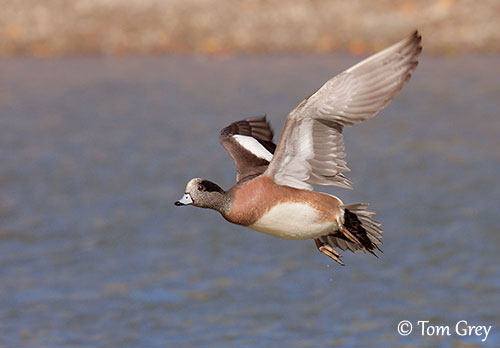Fr: Canard à front blanc - Canard d'Amérique
Ang: American Wigeon
All: Kanadapfeifente
Esp: Silbón Americano
Ita: Fischione americano
Nd: Amerikaanse Smient
Sd: amerikansk bläsand
Photographers:
Tom Grey
Tom Grey's Bird Pictures & Tom Grey's Bird Pictures 2
Tom Merigan
Tom Merigan’s Photo Galleries
Simon Tan
PBase Bird galleries
Text by Nicole Bouglouan
Sources:
HANDBOOK OF THE BIRDS OF THE WORLD vol 1 by Josep del Hoyo-Andrew Elliot-Jordi Sargatal - Lynx Edicions - ISBN: 8487334105
GUIDE DES CANARDS, DES OIES ET DES CYGNES – de Steve Madge - Delachaux et Niestlé - ISBN: 2603013769
THE HANDBOOK OF BIRD IDENTIFICATION FOR EUROPE AND THE WESTERN PALEARCTIC by Mark Beaman, Steve Madge - C. Helm - ISBN: 0713639601
FIELD GUIDE TO THE BIRDS OF NORTH AMERICA - National Geographic Society -ISBN: 0792274512
All About Birds (Cornell Lab of Ornithology)
The Birds of North America online
Bird Web (Seattle Audubon Society)
What Bird-The ultimate Bird Guide (Mitchell Waite)
Wikipedia, the free encyclopaedia
American Wigeon
Mareca americana
Anseriformes Order – Anatidae Family
INTRODUCTION:
The American Wigeon is the New World counterpart of the Eurasian Wigeon. It breeds on North America and winters S to South America, Hawaii and West Indies.
It frequents shallow freshwater wetlands when breeding, whereas during winter, it is mostly found in freshwater marshes, rivers and lakes, estuaries and bays, and agricultural areas. It typically nests on the ground, protected by vegetation.
It feeds mainly on plant material, eating parts of both aquatic plant and agricultural crops. Insects, molluscs and crustaceans are taken during the breeding season.
The American Wigeon has a large population throughout most of the range. Thanks to protected reserves, the species is now less threatened by hunting pressure and habitat reduction. It is not globally threatened for the moment.
DESCRIPTION OF THE BIRD:
Biometrics:
Length: 45-56 cm
Wingspan: 76-89 cm
Weight: M: 318-1134 g – F: 408-1043 g
The American Wigeon male in breeding plumage has greyish-brown upperparts with contrasting white wing-coverts visible in flight. There is a green-and-black speculum, often concealed under the feathers.
On the underparts, breast and flanks are pinkish brown. Rest of underparts is white, but undertail-coverts and vent are black. On the pale grey underwing, lesser coverts and flight-feathers are darker, whereas axillaries and median wing-coverts are white.
On the head, forehead and central crown are whitish. A dark green band extends from the eye to the nape. Sides of both head and neck are greyish.
The bill is pale bluish-grey with black tip. The eyes are brown, surrounded by dark area. Legs and feet are blue-grey to dark grey.
Compared to the Eurasian Wigeon, the present species has larger bill, and longer neck and tail.
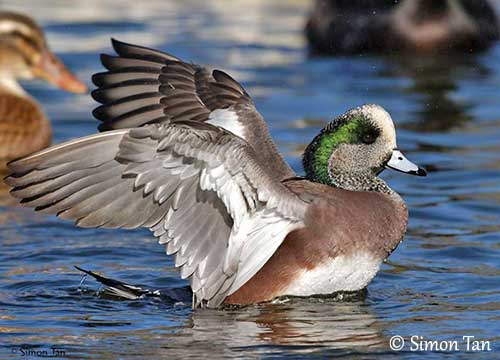
The adult female is mottled brown with whitish shoulder patches. The rump is dark with whitish edges to feathers. The outer uppertail-coverts are usually blackish with spaced whitish bars. The tail is dark grey-brown with white edges to rectrices.
On the underparts, the breast is pinkish brown with fuscous barring, narrower on the sides. Flanks are similar but with darker barring. The belly is white. The undertail area is blackish with variable white markings.
The present species has paler, greyer-coloured head contrasting with the body, compared to the female Eurasian Wigeon. Neck, forehead and crown are blackish finely mottled white.
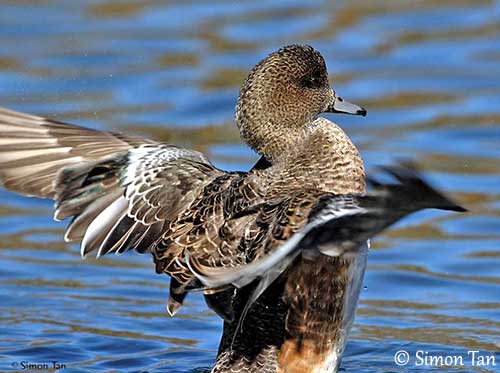
The juvenile resembles female but it has plainer markings on the back.
The young female is generally duller, with less black speculum lacking the green gloss.
RANGE:
The American Wigeon breeds in NW to CE North America, and S to NE California and N Colorado.
It winters S to N South America, Hawaii and West Indies.
HABITAT:
The American Wigeon breeds near freshwater marshes, pools and shallow ponds with exposed shoreline and submergent vegetation, and surrounded by meadows. It prefers country with scattered trees, and also nests in Arctic tundra and boreal marshes.
On migration, it frequents small and large lakes, quiet rivers, flooded areas and protected freshwater areas where it can find abundant food sources.
During winter, it can be seen in sheltered bays, estuaries, freshwater lakes, rivers and marshes. It may frequent saltmarshes and brackish coastal lagoons too.
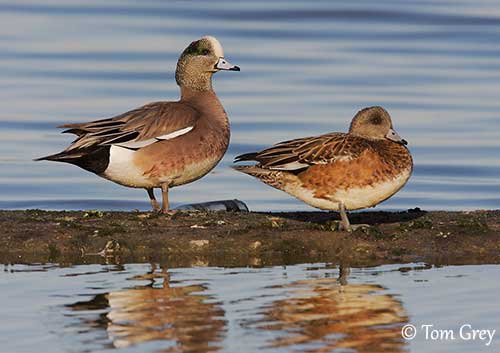
CALLS AND SONGS: SOUNDS BY XENO-CANTO
The American Wigeon produces a distinctive whistle “whew-whee-whew” and we can also hear quacks.
During courtship, the female produces a series of repeated, low growls “qua-auk qua-auk”. When she is disturbed with her brood, she gives soft, slowly repeated “errr” notes increasing in intensity as the danger is approaching.
BEHAVIOUR IN THE WILD:
The American Wigeon feeds primarily on plant material, and mainly parts of aquatic plants of genus Potamogeton, sedges, wild celery (Vallesneria americana), eelgrass (Zostera) and algae. During the breeding season, the female feeds mainly on insects and snails.
This species eats young grass shots on the ground, and also seeds and waste grains. The juvenile feed mainly on insects.
The American Wigeon forages in shallow water by taking food from the surface, or by submerging both head and neck to reach aquatic plants. It also feeds on land and usually in flocks.
On deeper water, it often joins groups of diving birds. It is able to steal them food as soon as they reach the surface. It is often seen with coots, Redheads and Canvasback.
The American Wigeon is monogamous and the pair usually forms on the wintering grounds. One female is pursued by several males. During the displays, the male extends the neck forwards while lowering the head with the bill open. It raises the wing tips in order to display the white wing patches
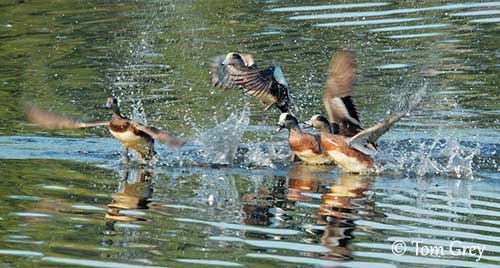
They nest on the ground in dry site, often close to water but sometimes up to 160 metres away from the shore. The female performs almost all the nesting duties.
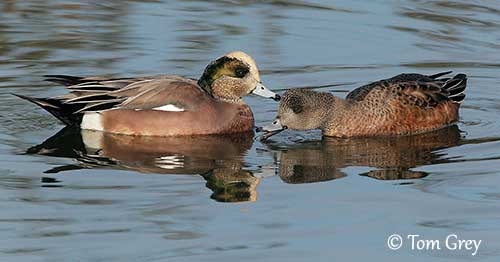
The American Wigeon is migratory and spends the winter further south of breeding range. Flocks are recorded in Europe (Ireland, Scotland, Azores and France), but the species occurs in numerous other Eurasian countries and in NE Siberia, Korea, Japan, E China, Taiwan and Guam.
The flight is swift and direct with strong wingbeats. This duck takes flight the instant it is disturbed.
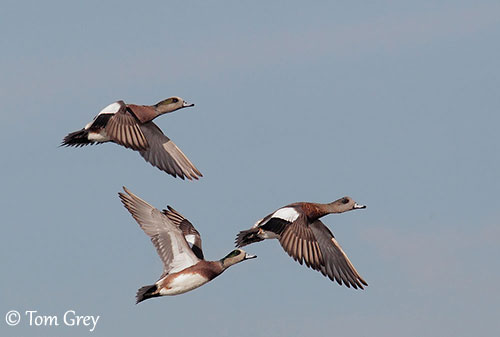
REPRODUCTION OF THIS SPECIES:
The egg-laying starts in May. The nest-site is selected by the female. The nest is usually hidden among tall grass or in shrubs or other natural cover on dry land, more or less close to water. The female builds a shallow depression with grass and plant stems, lined inside with softer material, usually down.
She lays 7-10 creamy-white eggs and incubates alone during 23-24 days. The male leaves the breeding range before the eggs hatch.
The young leave the nest very soon after hatching. They have dark brown down above and buffy below, and well-defined facial stripes. They are able to feed themselves. The female remains with them until they are almost fully grown. They can fly between 45 and 63 days after hatching.
PROTECTION / THREATS / STATUS:
The American Wigeon has very large range and the population is apparently stable, with expansion eastwards of the breeding range, in E Canada and NE states.
It is one of the most abundant dabbling ducks in North America, and is a common visitor to the boreal forest.
The species has suffered habitat reduction and heavy hunting pressure, but the numbers have remained stable thanks to protected reserves established in good sites.
The American Wigeon is not globally threatened, and currently evaluated as Least Concern.
